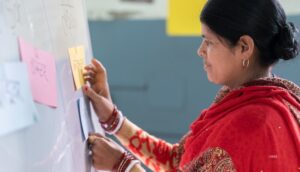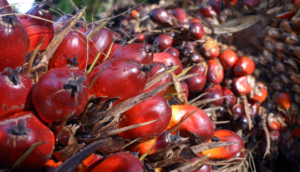Since launching our sustainability ambition for the future of coffee two years ago – Coffee LENS – we’ve seen coffee prices swing from a four-year low, to record highs. The current spike will be offering some respite to the world’s 12.5m smallholder producers. But as the coffee cycle goes, high prices induce oversupply from the already ‘better-off’ farmers with larger farms, triggering an inevitable price trough. Such is the market rollercoaster that coffee farmers have experienced for the last 40+ years and its increasing volatility is raising questions over the viability of smallholder production.
We’re seeing a growing inequality in the global value chain with Brazil and Vietnam now producing more than half the world’s coffee, up from less than a third 20 years ago. This is due to mechanization, accessibility to finance, higher yielding varieties, as well as better know -how in these origins. Meanwhile, smallholders often lack the means to invest in more resilient hybrids and other climate adaptation methods for the future.
Speaking on the back of the London Declaration in 2019, I proposed a price stabilization fund to subsidize farmers in times of low prices, while helping them mitigate the long-term impacts of climate change. I still believe that such a mechanism is needed to lift farmers from a continual limbo, but it will take time for industry to coordinate with development organizations and commercial banks to enact meaningful change. Importantly, there are three actions that can be taken now, critical in supporting producers in low-income countries to become more resilient in the face of market and climate shocks.
Firstly, upskilling farmers in specialty origins where quality improvement along with yield enhancement can lead to significantly higher incomes for producers and their families. Safeguarding the diversity of coffee is key to protecting consumer choice and increasing consumption. The incredible range of flavor profiles and blends on offer – from a citrusy Colombian black honey to the dark chocolate notes of a washed Kivu coffee – is rooted in the diversity of varietals, climates and terroirs spanning the coffee belt. ofi’s coffee teams have been training farmers on improved post-harvest techniques, alongside GAP, to improve the quality of their beans. Last year, processing equipment including drying beds, eco-pulpers and solar dryers were also distributed to 6,500+ producers across nine origins. And for improving the quality of their beans, farmers were rewarded with premiums worth US$12m in total.
Second, is really understanding what level of income allows farmers, particularly those with less than two hectares, to achieve a decent standard of living. For this reason, we’ve developed a tool based on a methodology piloted by Rainforest Alliance to estimate the living income gap of farmers across our supply chains and highlight where poverty hotspots lie. For the three coffee supply chains currently available on the tool, we can see that the share of farmers earning above the living income ranges from ~40% in Honduras, to just ~10% in Uganda[i].
We can also apply this tool to simulate the impact of different income drivers such as quality premiums, or income diversification. Even with the usual caveats about inbuilt assumptions, the tool can give us a better understanding of the most effective interventions at closing the living income gap for these smallholders. As we develop its scope, we’re looking to take the tool beyond our supply chains to help align understanding and action across the sector.
Meanwhile, the more progress made on farmer incomes, the more likely we are to shift perceptions amongst smallholders from coffee farming being the reason for poverty, to a way out of it. Every cycle of low prices drives the next generation of coffee farmers in the less efficient producing countries away from their parents’ farms and towards the cities. Even for those that aren’t put off, the rising cost of land, fertilizers and other inputs required to grow a crop that takes up to three years to bear fruit, creates an additional barrier. The nine family succession projects ofi ran last year in various origins, were designed to set up young adults with the basics of good farm management to try and give them a head start on running a profitable farm. And in Peru we’ve supported the applications of nearly 600 farmers to obtain land titles[ii].
These achievements contribute to our 2025 goals under Coffee LENS and are published in our first impact report. It shares progress made in collaboration with our customers and partners towards farmer livelihoods, child labor prevention, and climate action.
This brings me to my third action. We need to bring in landscape partners to these programs – from industry, governments, and NGOs – so we can reach beyond the 105,000 coffee farmers we’ve supported with training and inputs, or the 2mn+ trees we’ve planted to promote regenerative agriculture. I want to invite new partners to join ongoing projects, like the Alliance for Sustainable Landscapes & Markets in Chiapas, Mexico to support with nutrition education and tackle malnutrition. Unlike agronomy, this area isn’t in our DNA, so we need to bring in the right expertise. Collective action is imperative for reaching our longer-term goals and solving the sector’s intractable challenges like poverty. Be the change with us for a fairer, more resilient coffee future for people and planet.
[i] 2021 data
[ii] Circular Coffee Economy project
Editor’s Note:
Read more on coffee here.










